Kate Rauner's Blog, page 76
January 23, 2016
Eat Like a Martian-Potatoes #MarsSurvivalTips #Mars #NASA #science meets #scifi #book
 What does a newbie author have in
What does a newbie author have in 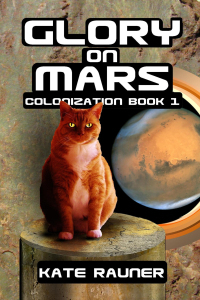 common with a best seller and with NASA? Potatoes.
common with a best seller and with NASA? Potatoes.
Recent science fiction stories agree – potatoes will provide the calories for the first human Martians.
NASA wants to know if that will really work.
NASA has launched a project to see whether potatoes could grow on the Red Planet, one day allowing a human colony… It is the most adaptable food staple… water efficiency, up to seven times more than for cereals such as wheat and corn… rich in zinc, iron and vitamin C.”
NASA will try growing potatoes “in conditions simulating those on Mars, including extreme ultraviolet radiation and drastic temperature variations.” No, NASA. We scifi authors know you need a greenhouse of some sort – probably with artificial light since the place must be shielded from radiation.
It may be that vegetables colonize Mars before people do, perhaps with robots tending to them.”
Today, Mars is the only planet we know of that’s inhabited entirely by robots. Maybe soon, by potatoes, too.
More Eat Like a Martian:
fish supper
mealworm snack
practice for Mars on Earth
Banana beer from Born on Mars
And Liz, in Glory on Mars, tries to make bhang, though she doesn’t have all the ingredients.
Filed under: Kate's Books, Neat Science News, Science Fiction








January 20, 2016
Crow’s Funeral #poetry
The deceased lies before them,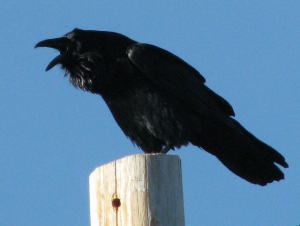
The crowd is all in black.
They’re watching for the villain
Who may be coming back.
It’s not known if they’re mourning,
They do not shed a tear.
They watch and they remember
In anger what to fear.
Humans are unusual
In tending to their dead.
Elephants, chimpanzees,
And porpoises, it’s said,
Will touch and groom,
Seem agonized.
But do they soon forget?
Only corvids, of the birds,
Gather for a wake.
As crows attend a murdered friend
Plan vengeance they will take.
By Kate Rauner
Thanks to livescience.com. I’ve seen heart-breaking videos of elephants grooming a dead herd mate – especially a mother with a dead baby. I believe they mourn. My llamas don’t seem to react much to a dead herd mate’s body, but I’ve watched them search for a missing friend.
Another crow poem: Crow and Pitcher
Filed under: Poetry Tagged: corvid, crow, death, funeral, poem Ravens live with me, raven, wake








January 16, 2016
Mission to Saturn Hardest of Hard #SciFi #book #space

‘Judith Beheading Holofernes’ by Caravaggio in 1599 – PD in USA. What’s that got to do with Saturn Run? Read on…
John Sandford is best known for his prolific series of hard-boiled suspense thrillers, but here tackles science fiction with co-author Ctein in Saturn Run.
An American telescope detects an object entering orbit around Saturn. Natural objects don’t act this way – it must be under intelligent control and no one else on Earth seems to have noticed. The Chinese are about to launch a colony to Mars, so they could quickly repurpose the mission and beat America to Saturn and whatever awaits there. So the race is on with only America aware they’re running – at first.
No Wantum Mechanics
A large part of the story follows how the characters turn an existing Earth-orbiting space station into a ship that can reach Saturn in a remarkably short time. The authors reject “wantum mechanics,” or “totally made-up non-science that saves the crew in the last dozen minutes of a bad Star Trek episode. ‘Captain, if we invert the polarity of the phasers and couple them to the warp drive, we can produce a beam of… unbelievablon particles.'”
As explained in the fascinating Authors’ Note, they spent a lot of time solving their technical problems, even running orbit simulations in a special Windows program. Saturn Run shares every bit of that effort with you. They admit to one piece of wantum mechanics, but given what that is (no spoilers in this review!), I think it fits the story.
What you get
are loads of technical descriptions and political machinations in a story that runs 448 pages in my epub edition. The story may be engaged in a race to Saturn, but the book is leisurely, taking its time to explore technology and present characters.
For example, one engineer is seated on a Virgin-SpaceX shuttle (nice tie-in to real-life) about to leave Earth for the space station. Instead of taking off right away, the story regresses to describing her amazingly automated apartment and the details of propulsion problems.
There’s even a cat on the mission – a detail I especially like since I sent a cat to the first colony on Mars in my book (shameless plug) Glory on Mars.
Here’s a taste of the book’s style:
• The f-bomb pops up quite a few times. [Meh. I’ve gotten used to it.]
• “A thousand kilometers above the Washington machinations, Captain Naomi Fang-Castro wrapped up the last meeting of the day, a report on the ongoing repairs to backup electrical storage units. The repair work was fine, bit there was a shortage of critical parts…” [Space can be as tedious as your job.]
• “She wasn’t an obligate vegetarian and vegetarianism wasn’t obligatory in space, especially not if you were the station commander.” [Interesting detail.]
• “He ripped off the top of the envelope, using the dangling ribbon that protruded from one end.” [How about – He ripped the envelope open.]
• “The ten o-clock train arrived three minutes after she walked onto the platform. She scampered aboard, sank into a seat, and sighed. She was twenty minutes from downtown Minneapolis, not much to see on the way but endless tracks of suburban houses. Way too late for sanity’s sake, and Senior Star power engineers didn’t get overtime.” [Not just technical issues get detailed treatments.]
• “Massive-scale heat pipes with fractal fluidic passages to pump the energy from the fissioning fuel into boiling superheated fluids that drove the generator turbines. Thermomagnetic liquids and magnetic pumps and transformers to siphon waste heat.” [The authors assure me this isn’t simply techno-babble.]
• “He lived in a condo complex built around an enormous swimming pool, and populated by affluent, good-looking people. Most affluent people were good-looking, not because they inherited the right genes, but because the surgery was so good and painless and safe.” [Basically irrelevant to the story.]
• “When the station personnel paused by the window, framed in a rectangle slightly wider than it was high, they looked like paintings by Caravaggio.” [This didn’t help me much – I had to look up Caravaggio, who gets mentioned three times.]
• “… unhitched the lid… pressed it up against… nudged the controller… fifteen-second pan… killed his rotation… did a slow zoom-in… moved closer… alarm beeped.” [I’m getting tired of typing, and admit I got tired of reading at times, too. I skimmed ahead to the part I was waiting for.]
How Saturn Run stacks up
From the common-wisdom writing advice I’ve read, only an established money-making author could get this much “telling” past an editor. But, the day I checked, Saturn Run was ranked 15th in its Kindle category (scifi space exploration) out of 2,235 titles. That means it’s selling in the top 1%. And you can’t claim Sandford’s reputation suckered buyers in. The book has 4/5 stars from 600 reviews.
Phenomenal.
But clearly this book is for fans of hard science fiction.
Glory on Mars is also called hard science fiction, but the flavor is very different – no physics lessons :) The first colonists to Mars have taken a one-way trip and that may be a mistake. Journey with them as they struggle to establish their colony and explore Mars near Olympus Mons, the largest (extinct!) volcano in the solar system.
Filed under: Kate's Books, Science Fiction Tagged: alien, China, John Sanford, mars, Physics, Saturn, science fiction, SciFi, Space Station, spacecraft, spaceship








January 13, 2016
Sun Pillar – #Haiku on #weather #sun #storm
Coming winter storm
Sends a pillar to heaven
In the early dawn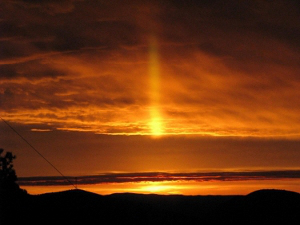
Filed under: Poetry Tagged: atmospheric phenomenon, poem, poetry, sun, Sun pillar, sunrise, weather








January 9, 2016
Trojan, Hollow Moon of Jupiter #SciFi #books
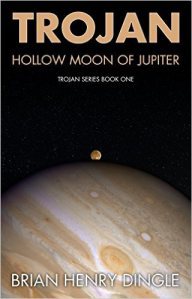 A hollow sphere nearly as large as the Earth appears in orbit around Jupiter. Humans have occupied the inside of the sphere and found the Nefra – a race of humans removed from Earth thousands of years ago. It’s hard to tell Nefra from humans because Nefra keep their tails hidden. I love this detail, since I always felt cheated by my lack of a tail.
A hollow sphere nearly as large as the Earth appears in orbit around Jupiter. Humans have occupied the inside of the sphere and found the Nefra – a race of humans removed from Earth thousands of years ago. It’s hard to tell Nefra from humans because Nefra keep their tails hidden. I love this detail, since I always felt cheated by my lack of a tail.
Review – No Spoilers
First Contact is in the past and Brian Henry Dingle’s book is a world-building tale. He has a fascinating, hard-science-fiction view of a world built inside a sphere that rotates fast enough to create near-Earth gravity on the inner equator while leaving a structure – the Carousel – in the center in zero-g. Zero-g offers advantages to severely injured patients and the Carousel includes a hospital for burn and trauma cases. Dingle is a medical doctor and his knowledge is evident throughout the story – for example, “tears filled his eyes and shined over his sclera.”
The story takes place in the Carousel and on the sphere’s inner surface, with some action in space, orbiting Jupiter.
The book opens with a murder framed by a sort of prologue of police reports and interviews. Dingle has a strong vision and his gritty world is detailed. For example, sunlight is channeled through the sphere’s wall with quartz fibers – what a cool idea – and the sphere’s thick walls are mined for metals and carved into infrastructure. Dingle sometimes repeats his descriptions, as one character notices: “‘God, you’re repeating yourself.’ Calamnos said. ‘Because you need to know.'”
This is a nasty, dirty, dimly-lit world. Plastic pre-fab buildings brought from Earth are “variegated pukey pink.” Many inhabitants are pitiful -or despicable. Trojan is rife with drug addicts and criminal gangs.
Drunks and addicts are targets for murder. A couple police detectives begin to track percular attacks and the latest victim survives – barely. But the situation becomes more complicated as various factions, humans and Nefra, collide. Philosophy joins drugs and murder in the story.
Be warned that Dingle’s descriptions are vivid and intense in fight, torture, and hospital scenes.
Dingle sometimes repeats himself, but as a mixture of scifi world-building with mean streets, this is a four-star story.
It’s fun meeting other indie authors – see Brain’s review of my book Glory on Mars here.
More links:
Trojan, Hollow Moon of Jupiter Buy on Amazon
Brian Henry Dingle on Goodreads
Brian’s post on the physics of Trojan, creating a fictional world
Filed under: Science Fiction Tagged: alien, detective, hollow moon, hollow world, Jupiter, mean streets, murder, science fiction, SciFi, world building








January 6, 2016
#Elephant Phone Ahead – #Wildlife #Poetry
Tamil Nadu, in India,
Where wildlife still roams,
Protected Asian elephants
Have trampled village homes.
A couple people every year
Die in these encounters
But none at all were killed last year
Crossing tea plantations.
You can sign up for text alerts
Or hear a voice message,
See flashing light on towers high
When elephants make their passage.
Rangers can escort the folks,
Or residents walk away.
Teams of plantation workers, too,
Prevent a deadly day.
Instead of calls to slay the herds,
People now say, leave them
To cross the tea plantation groves
Safely in the ev’nings
By Kate Rauner
The area’s elephants are stuck in forest fragments. They move from one patch to another at dusk when workers are walking home from tea plantations. In the growing darkness, even an elephant is hard to spot, and a startled elephant will charge.
Living with wildlife has its joys and dangers. I live on the edge of the Gila National Forest and two of my llamas were killed by black bears. It’s hard to condemn people who retaliate after loved ones are trampled or houses damaged.
We rural folks get little sympathy from wildlife advocates, but saying the animals were here first doesn’t solve the problem for people or wildlife.
As for those houses elephants broke open:
“Most of the damage happens on the kitchen side, because [elephants] are looking for something in there to eat, such as salt or rice.”
Smart creatures! But if you set out food or salt for them in remote locations, what unintended consequences will you create?
It’s nice to see technology help solve the problem.
Thanks to NatGeo.
Filed under: Poetry Tagged: elephant, India, poem, poetry, rampage, tea plantation, text








January 2, 2016
Good #NASA News for Colonizing #Mars? #SciFi thinks about such things in #book :)
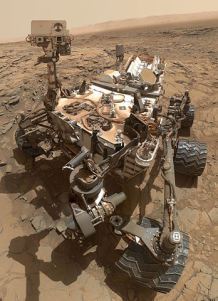
Look at its wheels – not a sand dune
NASA found high levels of silica southwest of my Born on Mars Cerberus Base. That’s good news for science fiction colonists.
Today on Earth, Ferrock (TM) by Iron Shell LLC is a replacement for concrete made from powdered iron, ground glass, and carbon dioxide. Since concrete manufacture generates greenhouse gasses, it may help us reduce the rate of global warming climate change.
But there will be no concrete on Mars – there are no vast limestone, shell, or 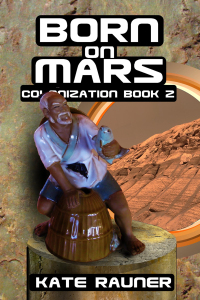 chalk layers deposited by living creatures to use as cement. What will colonists use for building material?
chalk layers deposited by living creatures to use as cement. What will colonists use for building material?
In my On Mars Series, settlers have construction robots that use a 3-D printing technique to laser-sinter stone into building shapes – too bad that technology’s not quite here yet.
If colonists can find iron meteorites or iron ore in lava tubes, and dig up Curiosity’s silica, they can make their own Martian concrete. No problem finding CO2 – Mars’ atmosphere is 95% CO2.
More on NASA Curiosity’s discovery with here.
What we’re seeing on Mount Sharp is dramatically different from what we saw in the first two years of the mission,” said Curiosity Project Scientist Ashwin Vasavada of JPL. “There’s so much variability within relatively short distances. The silica is one indicator of how the chemistry changed. It’s such a multifaceted and curious discovery, we’re going to take a while figuring it out.”
Filed under: Kate's Books, Neat Science News, Science Fiction Tagged: Born on Mars, Curiosity rover, discovery, Glory on Mars, Jet Propulsion Laboratory, JPL, mars, Mount Sharp, NASA, science fiction, SciFi








December 31, 2015
Happy #NewYear :) #NewYear2016
 Here’s wishing you a safe and prosperous 2016. Thanks for the reads, the likes, and the comments. I love hearing from you.
Here’s wishing you a safe and prosperous 2016. Thanks for the reads, the likes, and the comments. I love hearing from you.
Kate
For your New Year’s Day feast, eat like a Martian:
fish supper
mealworm snack
practice for Mars on Earth
Banana beer from Born on Mars
And Liz, in Glory on Mars, tries to make bhang, though she doesn’t have all the ingredients.
Filed under: Kate's Books, Neat Science News, Poetry, Science Fiction Tagged: 2016, celebration, eat like a martian, happy new year, mars survival tips, new year, thanks








December 30, 2015
#Science and #Poetry in Pond Water
Immortal Sits Upon Your Thumb – by Kate Rauner
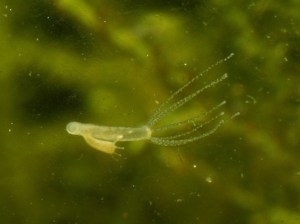
Hydra budding a baby
Do you want to live forever?
Immortality?
Uploaded to a cyborg mind
At the singularity?
Humans often end up cursed
When begging gifts from gods.
Beware of this approach,
You’ll find it to be flawed.
From deadly cinnabar,
Brew your own elixir.
Seek the golden apples,
Or Milk Ocean’s sweet nectar.
A simple little polyp
Achieves your heart’s desire.
Won’t deteriorate with age,
It’s life force will not tire.
Could sit upon your thumbnail,
This tiny glove of tentacles.
Forever totipotent,
It’s mostly made of stem cells.
As long as it’s not eaten,
In clean pond water’s flow,
The hydra flaunts your greatest wish
And doesn’t even know.
I love to watch scientists follow their data, even when it leads away from their hypotheses:
I started my original experiment wanting to prove that hydra could not have escaped aging,” study researcher Daniel Martinez, a Pomona College biologist, said in a statement. ‘My own data has proven me wrong — twice… I do believe that an individual hydra can live forever under the right circumstances.’
Unlike most multicellular species, hydra don’t show any signs of deteriorating with age, according to the new research, published Dec. 7 in the journal Proceedings of the National Academy of Sciences.”
Thanks to livescience.com. Don’t try these.
Filed under: Poetry Tagged: cinnabar, elixir of life, fresh water polyp, gift of gods, Hindu Milk Ocean, Hydra vulgaris, immortality, singularity








December 26, 2015
Bobcat in #NewMexico #Wildlife
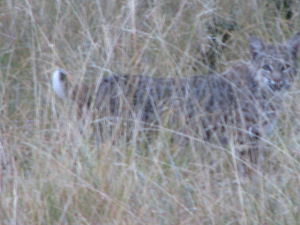 Photo may be fuzzy, but exciting too.
Photo may be fuzzy, but exciting too.
My house cat streaked up on the deck one morning, so I grabbed my camera and stepped out to see what upset her.
A bobcat glared at me from the driveway. By the time I raised the camera, it had walked into the grass. Bobcats prefer rabbits as prey – just the size of a kitty-cat. And they hunt at dawn and dusk, so low light accounts for the poor picture. But what a treat for me – especially since my house cat survived. This is only the second bobcat I’ve seen in the wild.
Filed under: Neat Science News Tagged: bobcat, Gila National Forest, kitty cat, new mexico, wildlife











